What is Systems Thinking ?
In this blog you will learn the basics of systems thinking. After reading you know what systems thinking is.
Based on Systems thinking for social change by David Peter Stroh.
Edited by Jan Jutten
Translated in English by Robert Pastoor
Select your own language with the button at the top right.
Click HERE for the original Dutch version.
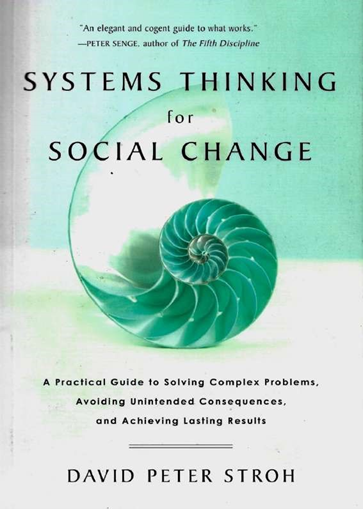
Introduction
Organizations and social systems have a life of their own!
For anyone who wants to make a change in such a system, it is important to know the forces at play. This makes it possible to work with these forces instead of against them.
With the help of systems thinking, it is possible to achieve sustainable results with less energy and fewer resources. Systems thinking is effective for several reasons:
- it shows us how we ourselves contribute to the creation of a problem;
- it stimulates us to start in those places where we can have the big impact; this can be done by reflecting on our intentions, our way of thinking and our actions;
- it mobilizes stakeholders to take actions that lead to greater effectiveness of the system as a whole rather than just focusing on its own interest;
- it helps us see the possible unwanted long-term effects of good intentions;
- supports in identifying interventions that have the most results;
- it motivates and supports people in a continuous learning process.
Good intentions are not enough
Providing shelter to the homeless perpetuates the problem.
The fight against drugs increases drug crime.
Food aid increases hunger in the world.
Training programs increase unemployment.
More remedial teaching in the school ensures more children with learning difficulties.
More asphalt leads to more traffic jams.
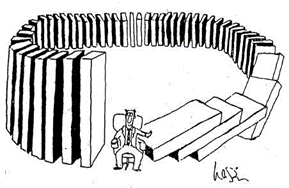
These are all examples where we see that there is a difference between intention and effect.
In all these problems, we see the same characteristics:
- the approach focuses on symptoms and not on the problems;
- often there are successes in the short term;
- however, these successes are offset by the longer-term negative consequences;
- these negative consequences were not intended;
- therefore, we do not feel responsible for the recurrence of the problem.
An example
The imposition of severe imprisonment for violent crimes does not address the socio-economic causes of urban crime. After the criminals have served their punishment, they return to society after a hard follow-‘education’ within the walls of the prison. Almost half of these people are re-convicted within three years. The system is weakened by the fact that fathers and mothers are locked up, families are pulled apart, less attention is paid to education and therefore more youth who grow up to become a new generation of criminals.
The distinction between conventional thinking and systems thinking
Conventional or linear thinking helps us tackle simple problems. With more complex problems, this way of thinking is not effective.
In conventional thinking, we divide reality into small pieces and we assume that we improve the big picture by focusing on these pieces.
In this overview we see the main differences between conventional (linear) thinking and systems thinking.
| conventional thinking (linear) | systems thinking |
| The connection between problems and their causes is obvious and easy to trace | The connection between problems and their causes is indirect and usually not easy to trace |
| Others, either within the organization or outside it, can be blamed and are the ones who need to change. | Unconsciously we create our own problems and we have a great influence on solving problems by changing our own behavior |
| Policies designed for short-term success will also contribute to long-term success | Quick, short-term solutions often have unintended negative long-term consequences. They have no effect or only make the situation worse |
| In order to improve the whole, we need to improve the individual parts | In order to improve the whole, we need to improve the relationships between the parts |
| We get results by taking several actions at the same time, separate from each other | We get results through some interrelated changes, aimed at sustainable improvement |

Systems and systems thinking
Donella Meadows describes a system as follows: “An interconnected set of elements that is coherently organized in a way that achieves something.” The essence is that a system is always aimed at realizing a goal. That’s why it’s so hard to change. The problem is that it is often not the goal we are aiming for!
In line with this, you can define systems thinking as follows:
“The ability to understand the interconnections in a system in such a way as to achieve the desired purpose.”
Systems thinking helps us to see the difference between the goal that the system achieves and the goal we pursue with it. Peter Senge calls it “The Fifth Discipline”, aimed at developing a learning organization. In addition to learning and working with a number of tools, systems thinking encompasses some other important dimensions:
- spiritual: the ability to see the opportunities that systems thinking has for people;
- emotional: learning to deal well with your emotions with the intention of serving a greater purpose;
- physical: the ability to bring people together to make them work together;
- mental: recognizing how our individual and collective mental models affect the results we achieve.

What is Systems Thinking in a change processes
How can systems thinking help shape successful change processes?
It supports us in dealing with four challenges:
- systems thinking motivates people to change;
People discover that they themselves play a role in the creation of problems and therefore also in solving them. - systems thinking stimulates collaboration;
People learn to see how they create the results together that nobody really wants. We will have to work together to change this process.
- systems thinking provides focus;
What interrelated actions should we take to achieve sustainable results? What levers are there?
- systems thinking continuously promotes learning with and from each other;
Learning with and from each other is crucial in an important change process. Change is almost always the result of a learning process.
These four challenges are summarized in the diagram below.
Challenges
| challenge | advantages of a systems thinking approach | characteristics of a conventional approach |
| motivation: why is change necessary? | shows everyone’s responsibility for the current situation | appeals to desire or fear |
| cooperation: why should we work together? | it shows that how our current way of working is our undermines individual and collective performance | tells people what to do |
| focus: what should we focus on? | uses levers that have the most effects on successful change | take several actions at the same time, independently of each other; combating symptoms |
| learning from and with each other: why? | makes it clear that our actions matter: learning together is necessary to see the consequences of our actions | assumes that “others” are wrong or guilty and then “they” must learn |
When is systems thinking effective
Systems thinking is applicable in many situations that are related to the development of a learning organization. It is highly effective if:
- a problem is chronic and the best intentions to solve the problem have not helped;
- various stakeholders fail to coordinate their actions despite their shared intentions;
- people or groups try to improve their part of the system without seeing and understanding their influence on the whole;
- undermine the short-term actions of some stakeholders’ intentions to solve the problem;
- people are desperately working on a large number of initiatives at the same time;
- working with solutions from elsewhere (good practices) at the expense of learning from and with each other.
The power of storytelling
Storytelling is a powerful tool to give meaning to our experiences. It shapes your identity, communicates who you are and what is important in your life. Stories often spur others into action.
People can tell beautiful stories about what they want to create. In such a story there are three recurring elements:
- eco-thinking: the world needs our commitment: we contribute to something outside ourselves;
- despite our good intentions and our commitment, we don’t have the influence we want to have. Hard work is not the same as working well;
- the biggest obstacles to this are the lack of resources and the behavior of others in the system.
The latter element in particular ensures that people are too reluctant and do not have the impact that is possible.
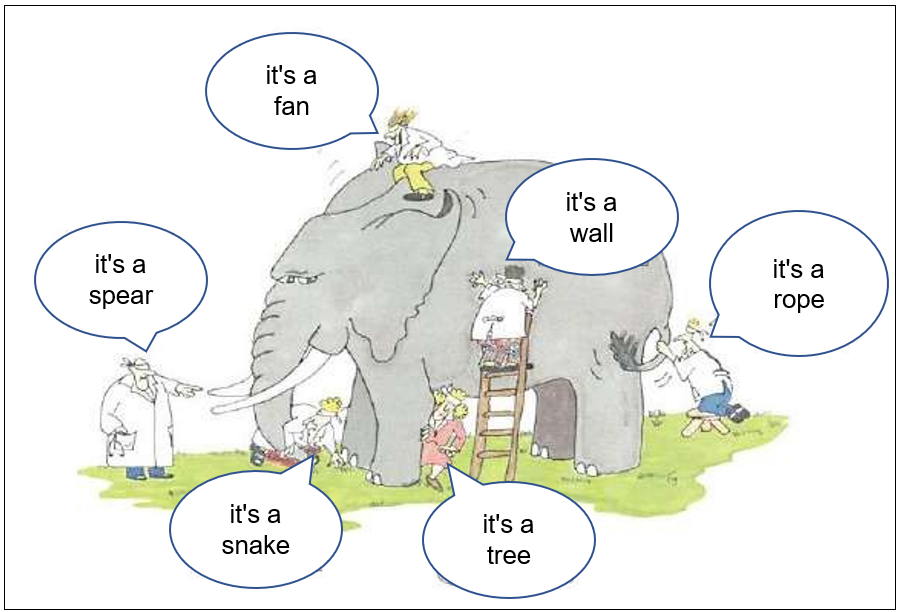
Another problem here is that people are too focused on improving their part in the system and not on the connections between the different parts. That is why it is important that they learn to see the whole and their own role within it through systems thinking . When that happens, the motivation to work together on the redesign of the whole also arises. People usually only feel responsible for the whole when they can see the whole!
This also means that when investigating problems and working on solutions, we try to get “the whole system to the table”: all those involved.
In the case of a complex problem in a school, these are, for example:
- the teachers
- the management
- some children
- parents
- an external who knows the school well
Of course, this depends on the nature of the problem. It’s about speaking from different perspectives. But always with the intention of improving the system by improving the connections between the parts and not by optimizing the individual parts!!
The iceberg
To learn what is systems thinking , you have to know one of the most important tools used when discussing problems: the iceberg.
It’s a simple way to distinguish between symptoms and problems (the underlying causes of the symptoms).
In the iceberg, we distinguish three levels of insight:
- the events
In many cases, we respond to this immediately, actions are taken quickly to eliminate the symptoms;
- patterns, trends
These are focused on what has happened and what may happen next if we do nothing. In this way we gain insight into the events over time.
- system structures
The causes of a problem can often be found in the underlying structures in the system:
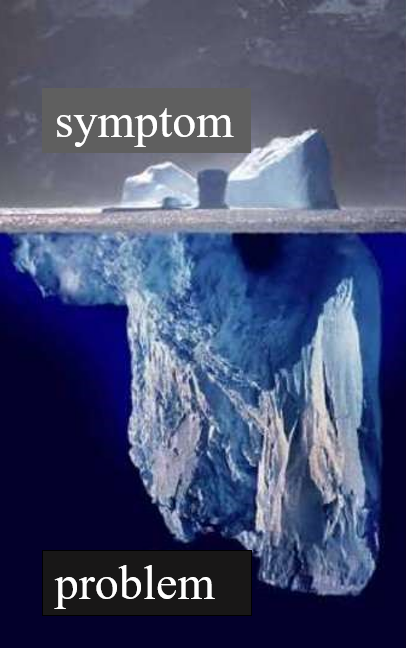
the relationships between the parts:
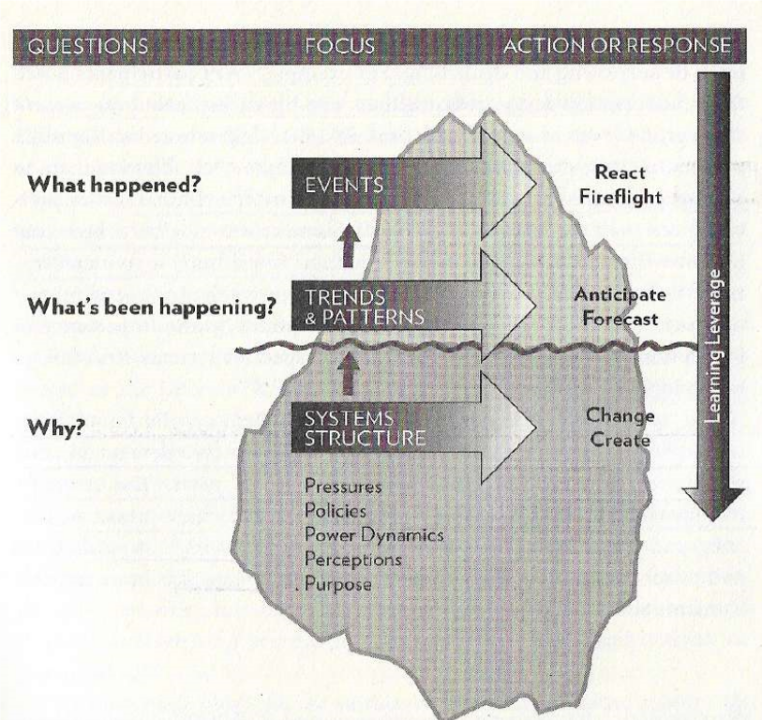
The language of systems thinking
Systems themselves continuously send signals through circular loops of cause and effect relationships. They are also called feedback loops. The term “feedback” has a different meaning in systems thinking than in communication, for example. It is meant that an effect through the feedback affects the cause, that a solution affects the problem.
In figures with causal loops, this mutual influence is represented with the help of arrows. For the purpose of the system thinking, a “new language” has been developed. The causal loops are an important part of this language.
To know what is systems thinking and learning a new language opens doors. So it is with the system language. Only when we know the basic rules of the system language and can apply them, a new world will open up. Moreover, language has a major influence on thinking. If we use a linear language, we will also think linearly and as a result act fragmented (first this, then that….)
Positive and negative relationships between variables
Variables are the building blocks of systems thinking. A variable is a scalable quantity: that means that elements that we place in a causal loop must be able to increase or decrease. Formulating good variables is one of the most important but at the same time one of the most difficult parts of systems thinking.
Characteristic of a system is that the elements within a system work together and influence each other. There is a structure. There is a relationship between variables or elements of a system. This relationship can be positive and negative. Note: the terms positive and negative have nothing to do with good or bad in systems thinking.
Positive relationship between variables
To learn what is systems thinking you have to remember the relationship is positive if an increase in one variable leads to an increase in the other. Or (and this is sometimes confusing) if a decrease in one variable leads to a decrease in the other. Positive relationship means here: both variables “go in the same direction”. A positive relationship is indicated by a +. In general, to avoid confusion, the S of “the Same” is used. We always place the S at the arrowhead.
An example of a positive relationship:
As self-confidence increases, performance improves.
Some other examples of positive relationships in a school:
Negative relationship between variables
The relationship is negative if an increase in one variable leads to a decrease in the other or vice versa. Negative means here: the two variables “go in a different direction”. A negative relationship is indicated by a – . In general, we use an O (from “Opposite”).
An example of a negative relationship:
The more a teacher teaches, explains everything himself, the less space and challenge there is for collaborative learning.
Some other examples of negative relationships in a school.
Reinforcing and stabilizing loops
In many situations, there is a double-sided relationship between variables. In such a case, we speak of a causal loop. What is systems thinking without causal-loops…
An example:
If the involvement of the participants increases, the return on the meeting will also increase. The other way around is also true: if team members experience that a meeting yields something, this will affect their involvement. If a relationship is two-sided , we note this as follows:
You can try what happens if you increase ^ involvement.
We distinguish in the system language two types of loops: reinforcing and stabilizing. To learn what systems thinking is, you have to understand the meaning of R ans B.
Reinforcing loops: positive feedback
With reinforcing loops, we see a form of feedback that ensures ever-increasing growth or decrease. E.g.: the more chickens, the more eggs. The more eggs, the more chickens (if you don’t eat the eggs…) The system language uses an R in the middle of the loop to indicate that we are dealing with a reinforcing loop.
Some examples of reinforcing causal loops in a school:
Click on Remix to zoom out
If self-confidence increases, this has a positive effect on performance, which further increases self-confidence. The other way around is also the case: less self-confidence leads to less performance and therefore even less self-confidence. Both have their reinforcing loops!!
In the other example, we see that the quality of the lesson leads to more involvement of students. This has a positive influence on the teacher’s job satisfaction and this in turn leads to a better quality of the lesson.
Stabilizing loops: negative feedback
Stability is very important for a system to survive. After all, continuous growth or decrease is not possible.
This stability is achieved via the so-called negative feedback. Stabilizing loops are also called balancing . Hence the use of the letter B in the diagram.
If there are a lot of prey animals, there is a lot of food available for predators. As a result, the number of predators increases. More predators means fewer prey animals. This leads to less available food for predators and thus to fewer predators.
When we are hungry, we eat and take in food. As a result, hunger decreases. Then we do not take in food for a while, which increases hunger again.
Most systems consist of combinations of stabilizing and reinforcing loops.
An example:
Extra beds in the hospital due to crowds
A hospital has taken 28 extra beds into use because of the crowds in the emergency department. The hospital says it can barely cope with the influx of vulnerable elderly people. In addition to extra beds, the hospital has also hired additional nurses. Other hospitals also report many elderly people in the emergency department.
Older people are now expected to live at home longer. The number of nursing homes is shrinking. That means the elderly go to the hospital when they need help. According to the hospital, that means a lot of extra costs that health insurance does not cover.
Archetypes
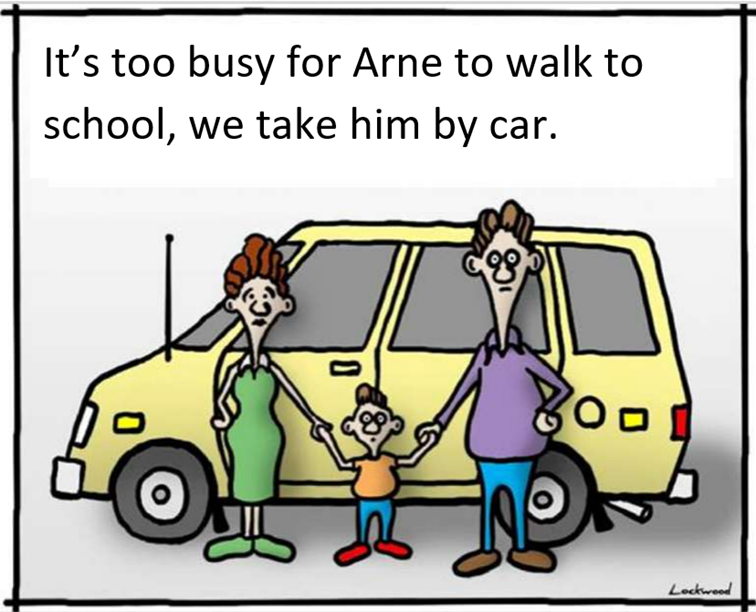
If we compare a large number of loops about problems in organizations, we will see that often the same types of loops become visible. Such causal loops that are common are also called archetypes.
Overview of archetypes.
| archetype | questions you can ask | |
| palliatives with a counterproductive effect unintended side effects | Have any quick actions been taken to resolve the symptoms without paying attention to long-term effects? Have we taken similar actions before? | |
| shearing the load unintentional dependency | Did the actions aimed at symptom control divert attention from working on a real solution? Do the actions have adverse consequences for the learning and self-solving capacity of the school? | |
| limits to growth unexpected limitations | Have successes come to work against us in the long run? Are there any recognizable boundaries in the system that slow down further development? | |
| escalation unintentional rapid increase | Is there a case of two parties where the actions of one party pose a threat to the other? Does each party have the ability to avenge itself with the same kind of actions? | |
| the tragedy of the open field optimizing the parts at the expense of the whole | Do two or more people have the opportunity to use a limited amount of resources without restrictions? Does the unlimited use lead to “drying up” of the source? | |
| adjusting the goals watering down the wine, lowering the bar ever lower | Is there a question of letting go of the original vision or goals? Are people focused on getting rid of the feeling that goals are not being achieved instead of focusing on realizing the goals? | |
| success for the successful “the winner takes it all” | Is there a choice between two or more options where the decision is made in favor of the successful(s)? Is the success of one determined by the means and opportunities offered to him and not to the other? | |
| growth and too little investment too little attention to the facilitation that makes growth possible | Are investments made in response to growth or anticipated? Are problems that arise in the organization the signal to start investing? |
palliatives with a counterproductive effect / unintended side effects
shearing the load / unintentional dependency
escalation / unintentional rapid increase
limits to growth / unexpected limitations
Systems thinking and change processes
The principles, working methods and tools of systems thinking can be applied effectively in change processes.
One of the characteristics of such a process is that it tries to bring “the whole system” to the table, especially when it comes to important changes. By bringing “the system” to the table, we can discuss the problems and the challenges from different perspectives. Otto Scharmer calls this “sensing the whole”: enabling the various parties involved to see the big picture and not just their own part.
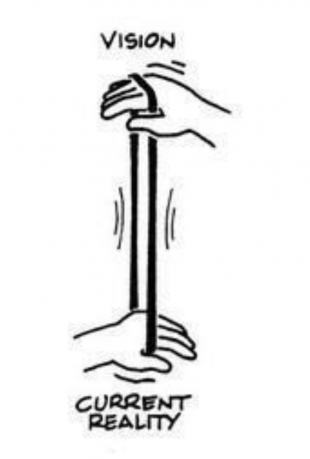
David Peter Stroh’s change process is based on the model of creative tension developed by Peter Senge. It shows the difference between the vision and the reality. The model can be used both individually and collectively.
To know what is systems thinking it can help in particular to visualize the current reality and to understand it better: understanding before intervention! For a successful change process, it is necessary that people have a common aspiration (mission, values, vision) and also a shared view of the current reality. The creative tension that this creates forms the basis of a change process
The process consists of four steps:
- Build a foundation for change and affirm the willingness to change;
- Who is involved in the process?
- What do we want to achieve together and where are we now
- Developing skills for good cooperation.
- Make the current reality clear by using the layers in the iceberg;
- Support those involved to see the whole picture
- What is going on? Why does it happen? What is everyone’s responsibility?
- Make a choice in favor of realizing the desired aspiration;
- What actions can we take to create together what we want?
- What effects can we expect in the short and longer term?
- What are the advantages of the change compared to leaving everything as it is?
- Start by bridging the gap between vision and reality through interventions that have the most effect (levers)
- Which interventions are needed and which ones have the most effect?
- Shaping a learning process.
- Giving everyone involved a role in the process.
- Constantly learning, refining, adapting.
What do you think?
By reading the text above you have learned the language of systems thinking. Now you know what is systems thinking . Do you have questions or suggestions? Please contact me.



